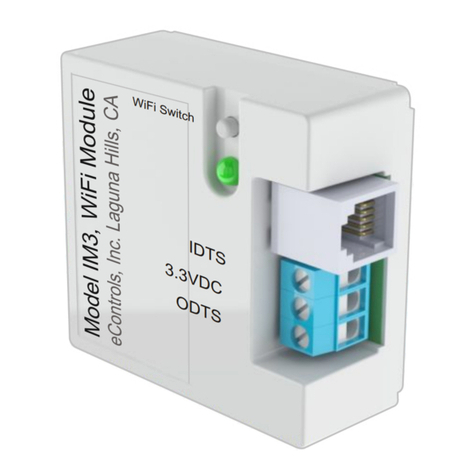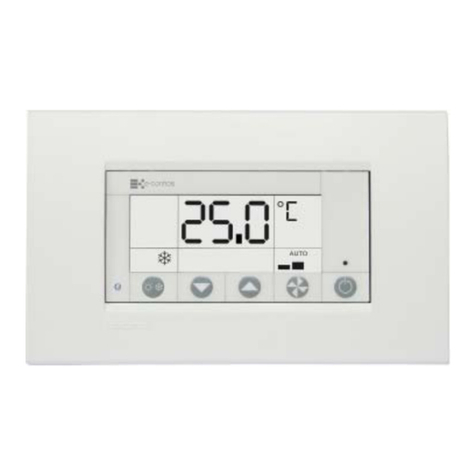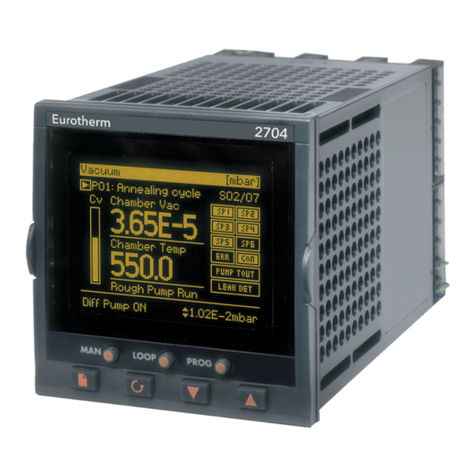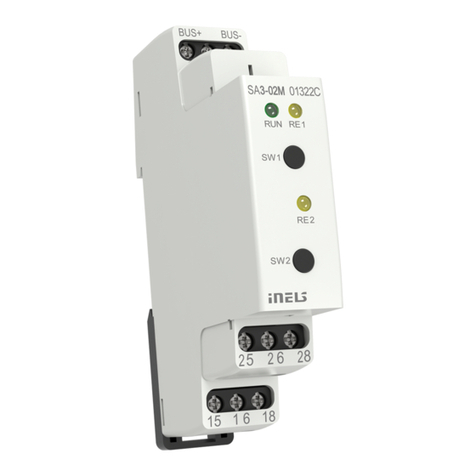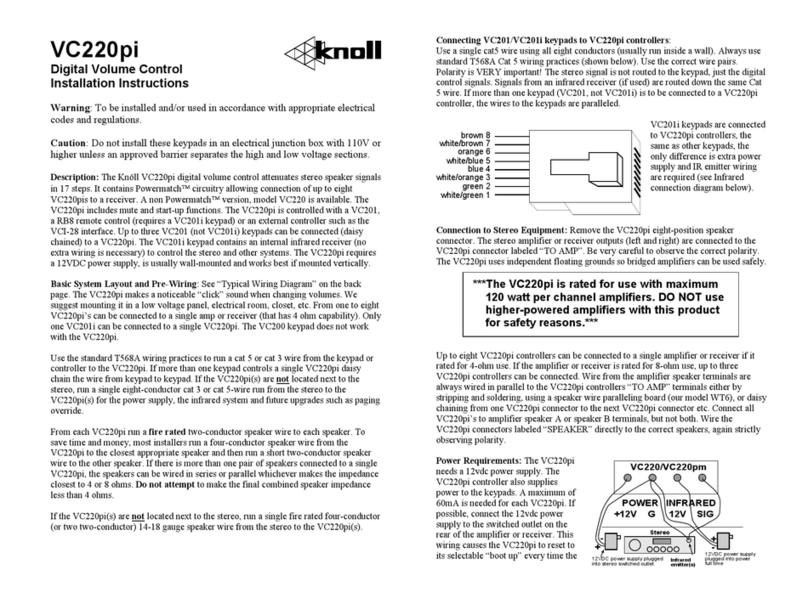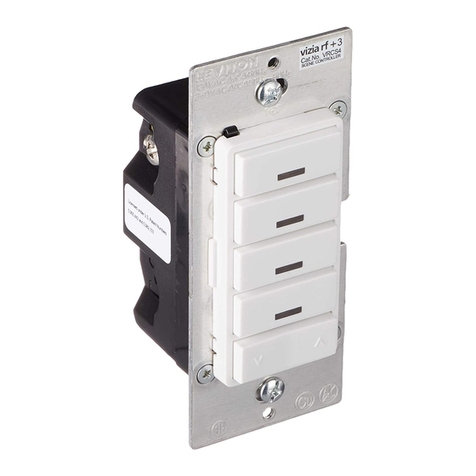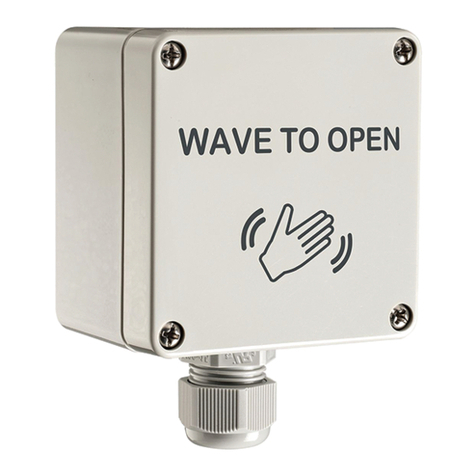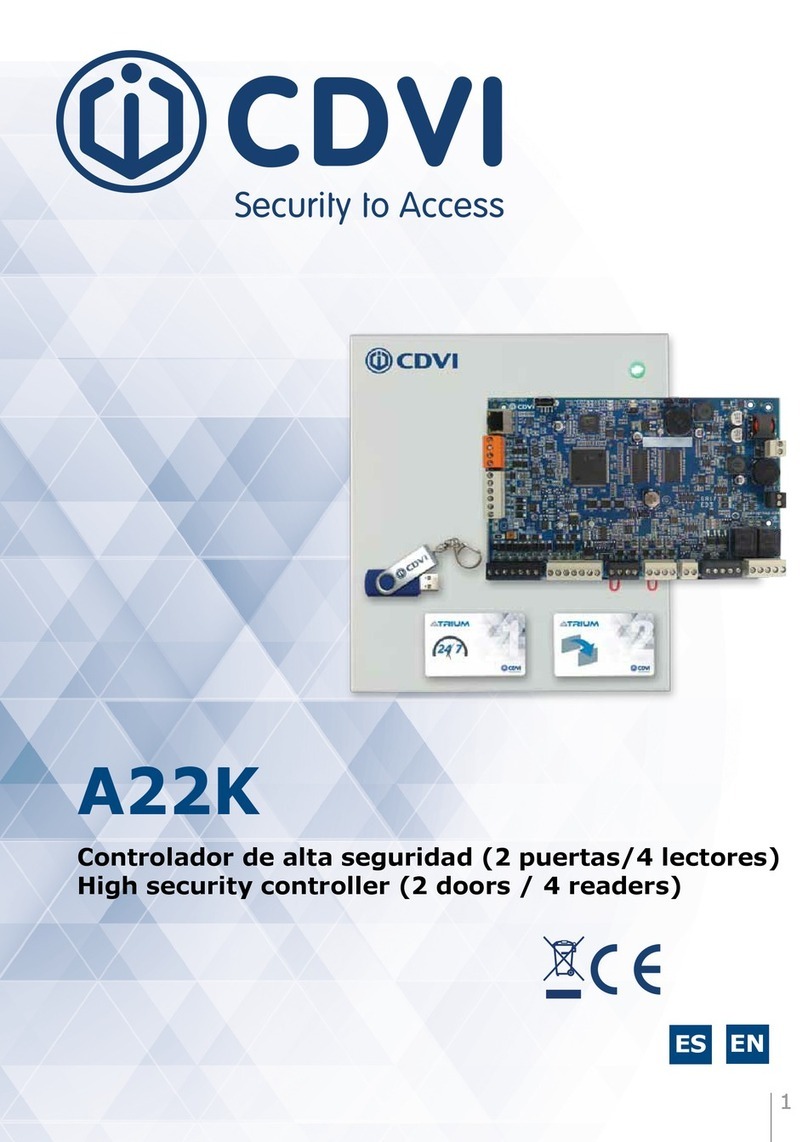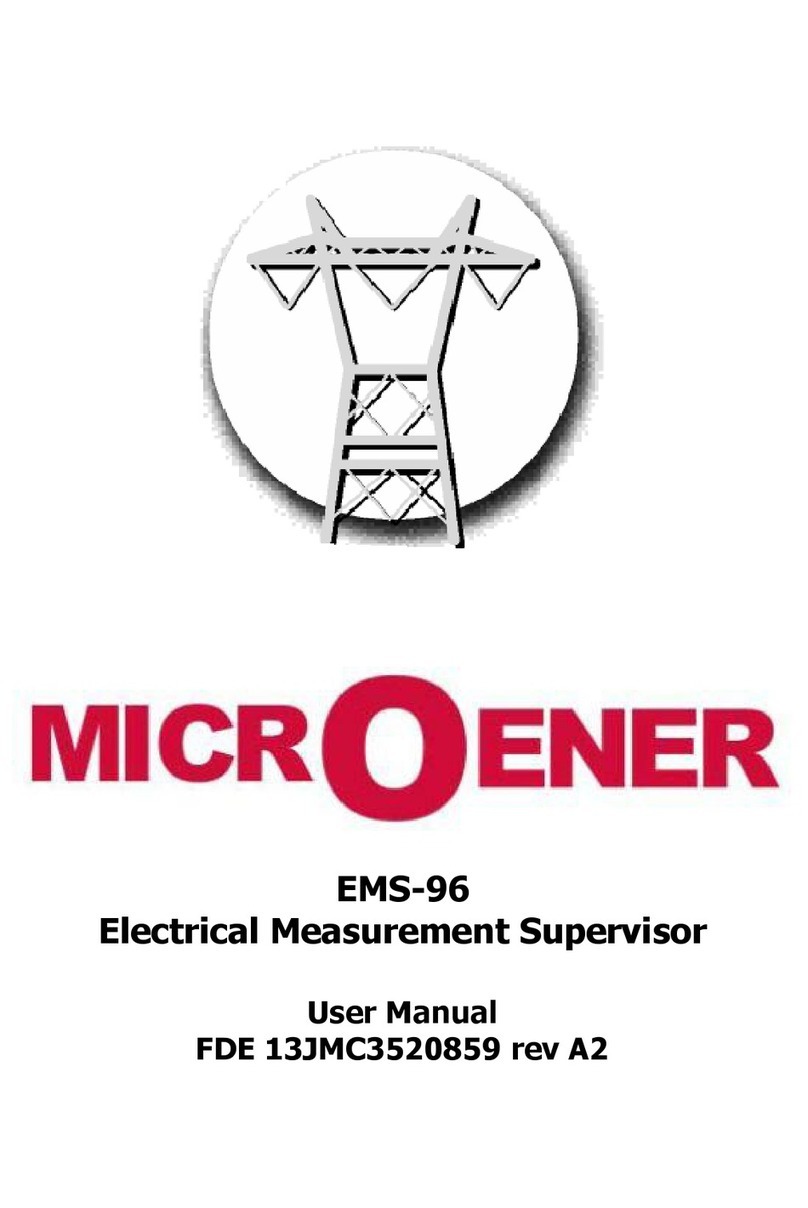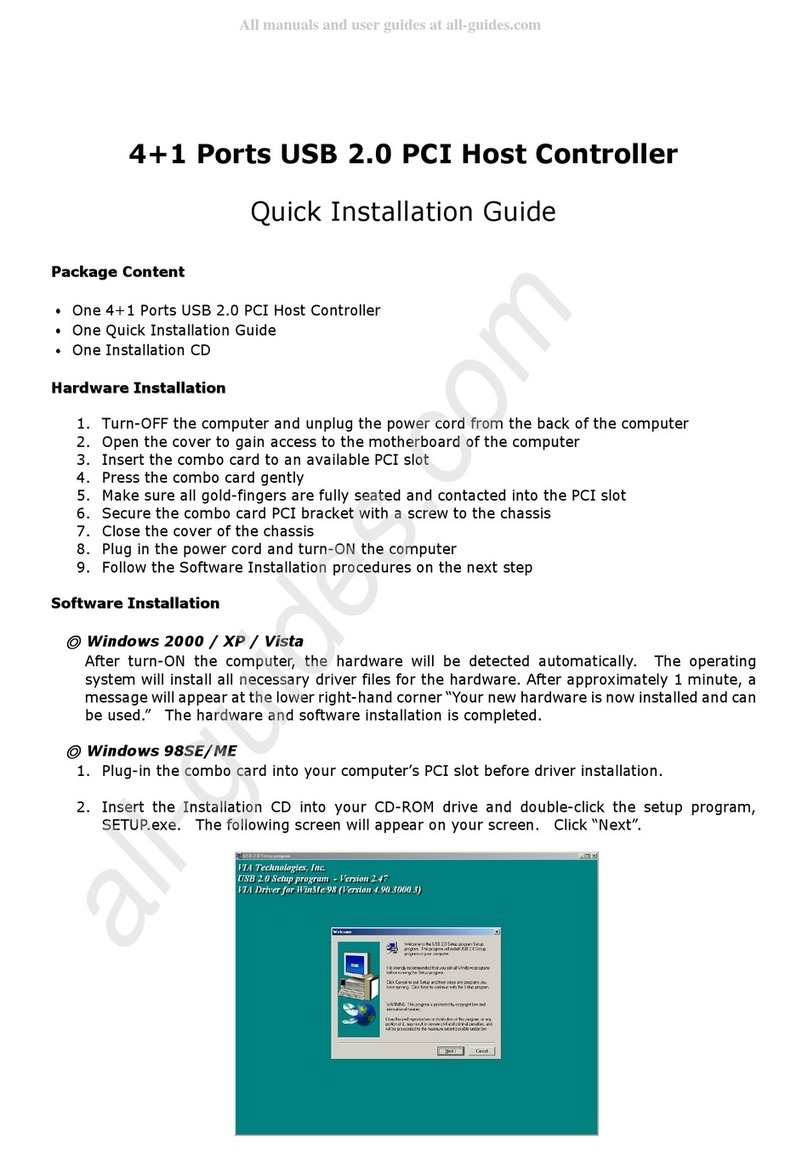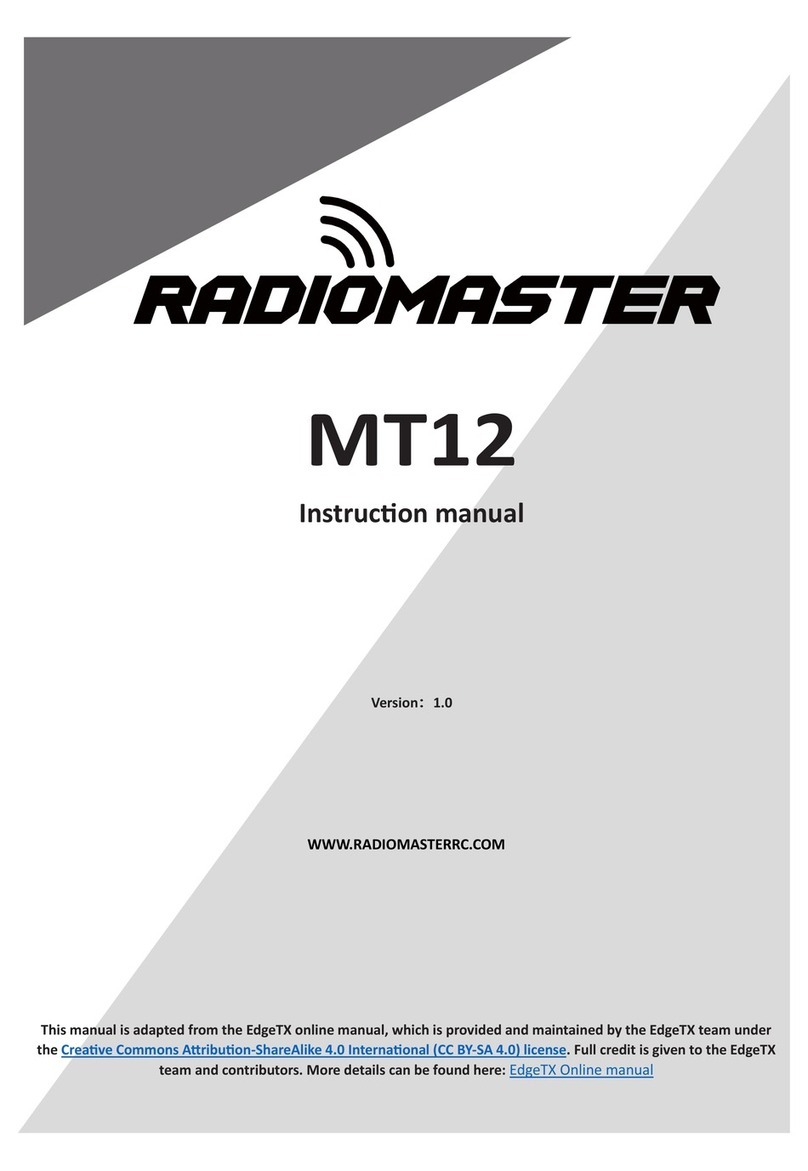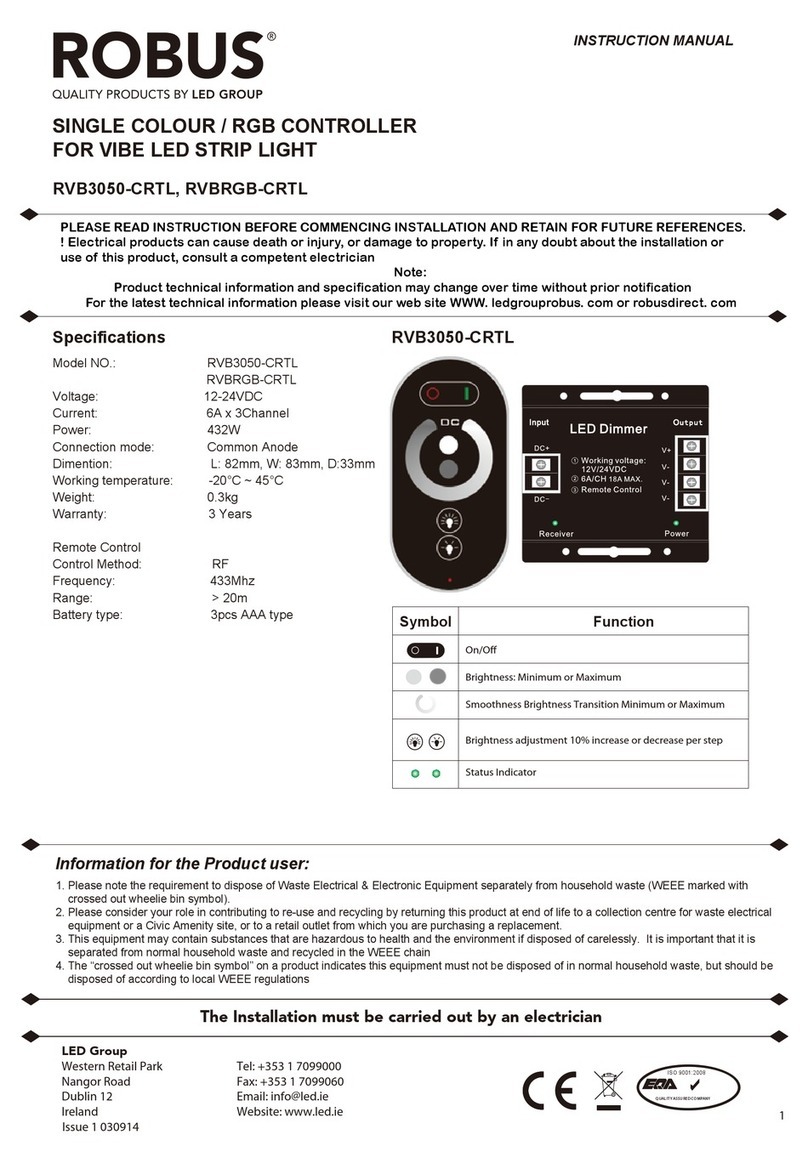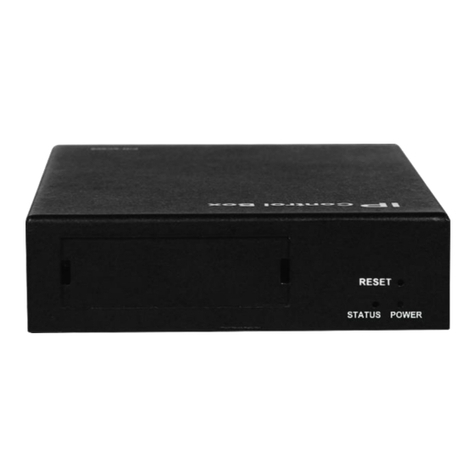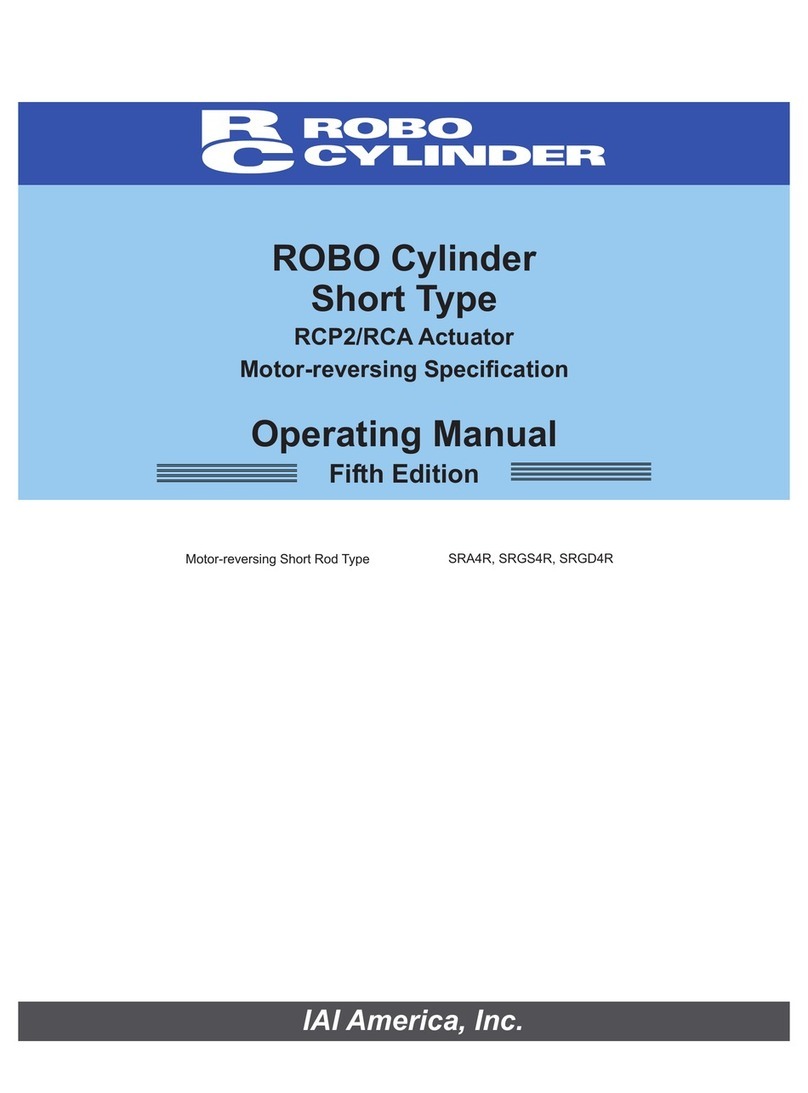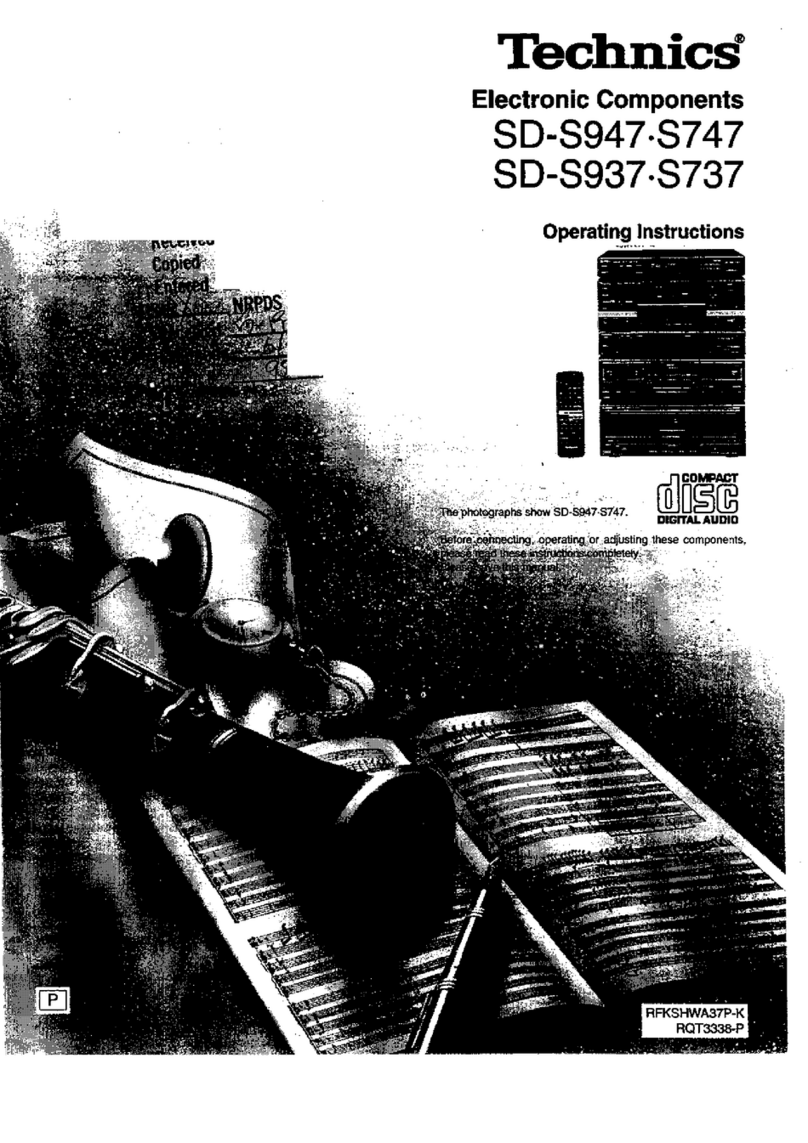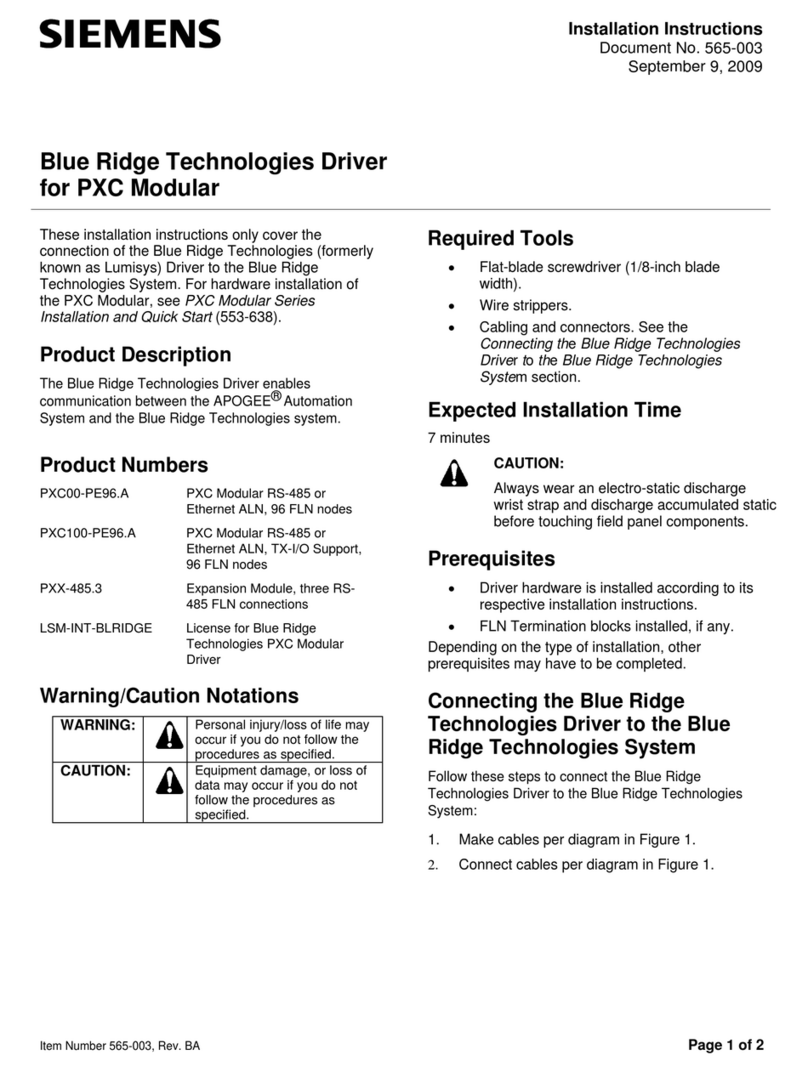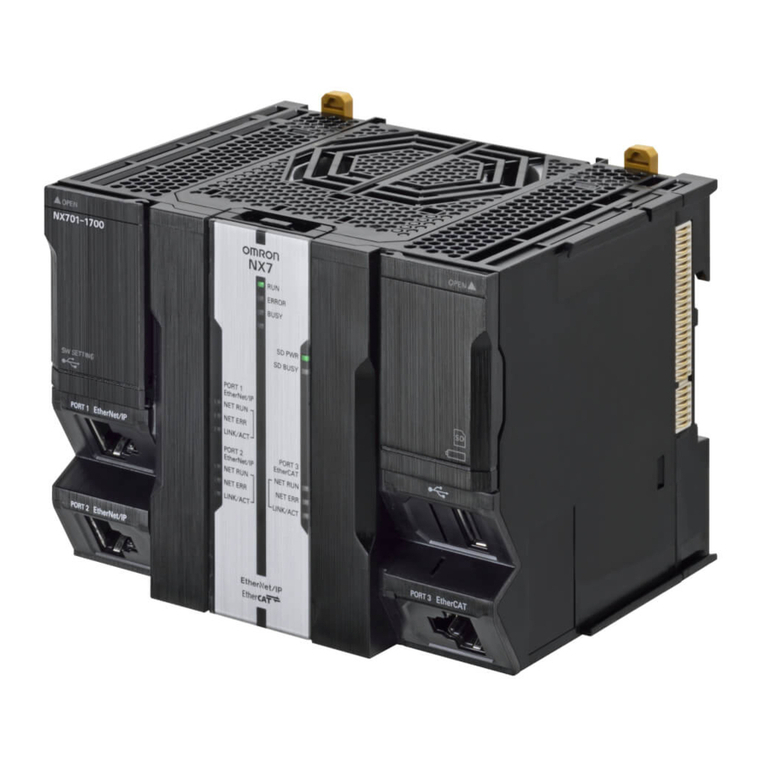eControls RT2 User guide

WHF
Smart
Outdoors
Link
Menu
ed
Set To
Cool
Indoors
Econo
Cooling
ON
oF
WHF
Smart
Outdoors
Link
Menu
ed
Set To
Cool
Indoors
Econo
Cooling
ON
oF
Homeowner and Installer Manual
Model RTK, Wireless WHF Control Kit
For 1, 2 or 3-Speed PSC or ECM Fans
Rev D Apr 2019
The RT2 is a wireless whole house fan (WHF) control
that can be placed on a night table or used anywhere
in the home to control the Whole House Fan using
temperature control for improved comfort and energy
efficiency or a built-in 1 to 12-hour timer. The fan speed
can be set from the remote. The RT2 has a wireless
range of 125 feet in a home or building.
Pat. Pending
Made in USA
QUICK START FOR HOMEOWNERS
The RT2 wireless WHF control is factory set to control your WHF using Temperature, just like your thermostat, and
improves your comfort and energy savings. Simply touch the Econo Cooling key to display ON, then set the Set To
o
temperature to your desired Indoor temperature. The WHF will turn ON when the Indoor temperature rises 1 above
o
the Set To temperature and turn OFF when the Indoor temperature drops 1 below the Set To temperature. The
following morning or when WHF operation is no longer desired, touch the Econo Cooling key to display OFF. As a
precaution, the RT2 control includes a built-in Safety Timer that will turn the WHF OFF after 8 hours of operation.
Before operating your Whole House Fan (WHF), always OPEN windows. See the WHF Owners manual for
more information. Your A/C should be off during WHF operation.
i
Operating your WHF using Temperature Control (See pages 2 and 3 for more information).
In the morning and/or before operating your A/C, make sure the RT2 control is set to Econo Cooling OFF.
If operating your A/C, make sure windows are closed.
Operating your WHF using Timer Control (See pages 2 and 4 for selecting and using Timer Operation)
Displays the indoor temperature.
Displays the outdoor
temperature when an outdoor
temperature sensor is installed.
Displays the WHF speed.
Indicates the RT2 is linked to
the RM2 receiving module.
MENU Key accesses
user options such as
Temperature or Timer Control.
Slide battery cover off to replace
the two AA batteries.
Use this key to turn WHF cooling
On or Off.
Displays the temperature setting for
WHF cooling.
Use the Up/Down keys to change
temperature setting or timer setting
in WHF cooling.
For more information on using the RT2, visit the
“eControls WHF Channel”, RT2 Homeowner Video.
Model RM2
WHF Radio Module
ODT
ODT
Laguna Hills, CA
eControlsUSA.com
WHF
Smart
Outdoors
Link
Menu
ed
Set To
Cool
Indoors
Econo
Cooling
ON
oF
WHF
Smart
Outdoors
Link
Menu
ed
Set To
Cool
Indoors
Econo
Cooling
ON
oF
WHF
Smart
C o n t r o l

HOMEOWNER - MENU OPTIONS
Select Temperature or Timer Control
01
The WHF can be controlled by temperature or by a built-in
timer. In Temperature Control, the RT2 control turns the fan on
when the room temperature rises above your Set To
temperature or turns the fan off when the room temperature
drops below your Set To temperature, just like your air
conditioner. In Timer Control, the user sets a number of hours
to run the fan using the built-in 1 to 12 hour timer. When the
time elapses, the fan turns off.
Press the ENTER key to save your selection and return to
normal operation or press NEXT to display the next option.
Press the MENU
key to display
Option 01.
Outdoors
Linked
Set To
Cool
Indoors
Econo
Cooling
OFF
oF
Option Option
Use the DOWN
key to select tp
for Temperature
Control (tP).
Or, use the UP
key to select tr
for Timer
Control (tr).
Next EnterNext
Enter
Set Safety Timer Hours
03
Option
Press the MENU key then press NEXT until Option 03 is
displayed.
Press the ENTER key to save your selection and return to
normal operation or press NEXT to display the next option.
Enter
Next
This option disables the touch screen for 30 seconds so
the screen can be cleaned with a soft damp cloth.
Option
Cleaning the Touch Screen
3
Press the MENU key then press NEXT until Option 04 is
displayed.
To disable the screen
and start the count
down, press the UP
key to select ON then
press the ENTER key
To exit the option and
return to normal
operation, press the
ENTER key.
04
Enter
Option Display Default
01
02
OPr
Str
Temperature
On
Description Selections
Select Temperature or Timer Control
Turn Safety Timer On or Off
Only displayed if Temperature Control is selected in Option01.
Temperature (tP) or Timer (tr)
On or Off
03
04
StH
CL
8 hours
Off
Set Safety Timer Hours
Clean the Touch Screen
4 to 12 hours
Off or On
Menu
Option
Enter
Option
Enter
Next
3
2
Use the UP key to
increase the
number of hours.
Or, use the DOWN
key to decrease the
number of hours.
i
Before operating your Whole House Fan (WHF), always OPEN windows. See the WHF
Owners manual for more information. Your A/C should be off during WHF operation.
Turn Safety Timer On or Off
02
Option
The Safety Timer automatically turns off the WHF after 8 hours
of operation to avoid inadvertently leaving the WHF On. The
number of hours can be set in Option 03. Press the MENU key
then press NEXT until Option 02 is displayed.
Press the ENTER key to save your selection and return to
normal operation or press NEXT to display the next option.
Enter
Next
Option
Enter
Next
Use the UP key to
turn the Safety
Timer On.
Or, use the DOWN
key to turn the
Safety Timer OFF.
Only displayed if Temperature Control is selected
in Option 01. Safety Timer is defaulted to ON.
i
Only displayed if Option 02 is On
In the morning and/or before operating your A/C, make sure the RT2 control is set to
Econo Cooling OFF. If operating your A/C, make sure windows are closed.
Only displayed if Safety Timer is set to On in Option 02.
The default number of hours for the Safety Timer is 8 hours
but can be adjusted from 4 to 12 hours.
i

HOMEOWNER - TEMPERATURE CONTROL
Turn Econo Cooling (WHF) ON
Set the Cooling Temperature
Change Outdoor Temperature Limit
1)
2)
3)
When EconoCool is On, the RT2 activates the WHF
when the indoor temperature is 1 degree warmer than
the WHF Set To temperature. The WHF is turned Off by
the RT2 when the cooler outdoor air has lowered the
indoor temperature 1 degree below the WHF Set To
temperature. The WHF will cycle On and Off as needed
to keep the space comfortable.
When an optional outdoor temperature sensor is
installed, the WHF will not be activated if the outdoor
temperature is above the outdoor temperature limit.
This improves energy efficiency and comfort by inhibiting
WHF operation when the outdoor temperature is too
warm to provide cooling.
Press the UP or DOWN key to change
the Outdoor Temperature Limit and
then press the ENTER key to return to
normal operation.
Outdoors
Set the Cooling Temperature
2)
Just like your air conditioning thermostat, set the cooling
temperature desired using the Up and Down keys.
Press the UP or DOWN key to set the
cooling temperature.
Link
Menu
ed
Indoors
Econo
Cooling
OFF
oF
Turn Econo Cooling (WHF) ON
1)
When Econo Cooling is On, the WHF will continue to
operate if the indoor temperature is warmer than the Set
To cooling temperature.
Press the ECONO
COOLING key to turn
the WHF On. On blinks
when WHF is active
and is solid when WHF
is not active.
Link
Menu
ed
Set To
Cool
Indoors
Econo
Cooling
oF
OFF
Change Outdoor Temperature Limit
3)
If an optional outdoor temperature sensor is installed,
WHF operation will be delayed until the outdoor
temperature is below the limit set.
Link
Menu
ed
Set To
Cool
Indoors
Econo
Cooling
ON
oF
Outdoors
Outdoor Temperature is displayed
here if an outdoor temperature
sensor is installed. The temperature
will blink when WHF operation is
delayed. Press this area to change
the Outdoor temperature Limit.
Enter
When Econo Cool is ON, the WHF will turn
ON if the Set To temperature is set lower
than the Indoor temperature, or turn OFF if
the Set To temperature is set above the
Indoor temperature.
i
Set To
Cool
Outdoors
Link
Menu
ed
Set To
Cool
Indoors
Econo
Cooling
oF
ON
3
Outdoors
Outdoors
i
If the Safety Timer is set to ON (see Homeowner -
Menu Options, Option 02 and Option 03), the WHF
will automatically turn off after the set number of
hours of operation. The Safety Timer is helpful to
those who may inadvertently leave the WHF on.
Before operating your Whole House Fan (WHF), always OPEN windows. See the WHF
Owners manual for more information. Your A/C should be off during WHF operation.
In the morning and/or before operating your A/C, make sure the RT2 control is set to
Econo Cooling OFF. If operating your A/C, make sure windows are closed.
Turn Econo Cooling (WHF) OFF
4)
On blinks when
WHF is active and
is solid when WHF
is not active.
Turn Econo Cooling (WHF) OFF
4)
Press the ECONO
COOLING key to
turn the WHF OFF.
Link
Menu
ed
Set To
Cool
Indoors
Econo
Cooling
oF
Outdoors
Link
Menu
ed
Set To
Cool
Indoors
Econo
Cooling
oF
Outdoors
The WHF will not
activate when
OFF is displayed.
ON
OFF
In the morning or when WHF operation is no longer
desired, turn the WHF OFF.

HOMEOWNER - TIMER CONTROL
Change the Preset WHF Timer
4)
The preset WHF Timer can be set from 1 to 12 hours
and can only be set when EconoCool is Off as shown.
Press here to
change the preset
WHF Timer.
Link
Menu
ed
Econo
Cooling
OFF
Press the UP key to
increase the hours or press
the DOWN key to decrease
the hours. Then press
ENTER to save.
End the WHF Timer
2)
The WHF Timer can be terminated and the WHF turned
off anytime.
Press the ECONO COOLING
key to turn the WHF Off.
Link
Menu
ed
Econo
Cooling
On
Adjust the WHF Timer
3)
The Timer can be adjusted during WHF operation.
Use the UP key to increase the time
remaining or the DOWN key to decrease
the time remaining then press ENTER.
Link
Menu
ed
Econo
Cooling
On
Link
Menu
ed
Econo
Cooling
On
Time adjusts in 1
hour increments.
Link
Menu
ed
Econo
Cooling
Off should be displayed. If not, press
the ECONO COOLING key to turn
the WHF Off.
OFF
Enter
Link
Menu
ed
Econo
Cooling
OFF
Off will be
displayed when
the WHF is Off.
Enter
Start the WHF Timer
End the WHF Timer
Change the Preset WHF Timer
1)
2)
4)
Adjust the WHF Timer
3)
When Econo Cooling is turned On, the WHF will operate
for the preset time period.
Press the ECONO
COOLING key to turn
the WHF On and start
the Timer. On will blink.
The remaining
time is displayed.
Link Link
Menu Menu
ed ed
Econo Econo
Cooling Cooling
On
Start the WHF Timer
1)
OFF
4
i
Before operating your Whole House Fan (WHF), always OPEN windows. See the WHF
Owners manual for more information. Your A/C should be off during WHF operation.
In the morning and/or before operating your A/C, make sure the RT2 control is set to
Econo Cooling OFF. If operating your A/C, make sure windows are closed.

HOMEOWNER - WHF OPERATION
For single speed WHFs, the fan speed will be displayed
as Hi and cannot be adjusted. For 2, 3 or variable speed
WHFs, the speed can be adjusted by pressing the Fan
Speed and using the UP and DOWN Keys.
Changing Variable Speed WHFs
5
Changing 2 or 3-Speed WHFs
Press here to change
the WHF speed.
Use the UP and DOWN keys to
select the fan speed then press
ENTER.
Medium speed (Int)
High speed (Hi)
Low speed (Lo)
Outdoors
Link
Menu
ed
Set To
Cool
Indoors
Econo
Cooling
ON
oF
Link
Menu
ed
Econo
Cooling
ON
Press here to change
the WHF speed.
Use the UP key to increase the
WHF speed or the DOWN key to
decrease the WHF speed. Adjusts
in 5% increments. Press ENTER.
Outdoors
Link
Menu
ed
Set To
Cool
Indoors
Econo
Cooling
ON
oF
Link
Menu
ed
Econo
Cooling
ON
Change the Fan Speed
Enter
Enter
Two AA Alkaline batteries are supplied with the RT2
Remote Control. Expected battery life is 1 to 2 years.
The RT2 backlight will dim or go off when it’s time to
change the batteries.
Although the batteries may be replaced with Alkaline
batteries, it is highly recommended that Lithium batteries
be used for a much longer battery life than Alkaline
batteries.
Large retail chains, such as Target and Walmart, carry
Energizer Ultimate Lithium AA batteries.
Changing Batteries
Slide the battery cover down.
Place the batteries in the RT2,
making sure the polarity is correct.
Slide the battery cover up. The
RT2 is now ready for operation.
If the RT2 is dropped or batteries are removed, there is a
built-in safety feature that will automatically turn the fan
off after 15 minutes without communication from the RT2.
Loss of Communication
The RT2 and RM2 in this kit are uniquely addressed and
only work with each other. If you need a replacement
RT2 remote or RM2 radio module, please contact us at
949-916-6701.
Replacement Units
Homeowner Help

INSTALLATION
CAUTIONS
Use cautions when mounting components to surfaces
that may have concealed wiring beneath the surface.
!
Turn off power before installing whole house fan or
WHF controls.
Read and follow all instructions carefully, including
those included with the whole house fan.
Follow all local electrical codes during installation. All
wiring must conform to local and national electrical
codes.
i
ATTENTION INSTALLER
Read entire manual before installing products.
When servicing WHF Controls or accessing products,
turn off all power to these items.
Connect the FC3J control board to the RM2 radio
module using the Plug&Play cable provided.
2)
i
Homes with plaster walls with steel lathe may experience wireless communication interference
when using wireless controls.
Install optional Outdoor Temperature Sensor and
wire to the RM2.
3)
4)
Installation should be performed by a qualified
individual with sufficient experience and skill.
If you are using a power cord to power the WHF,
the control board can be wired to the WHF, the
RM2 radio module connected to the control board
and options set before sending out for installation.
i
For more information on installing and using the RT2, visit the “eControls WHF Channel”, RT2 Installation
Video and RT2 Homeowner Video.
The RT2 wireless control and the RM2 radio module included in this
kit have been programmed with a unique ID number and ONLY
communicate with each other.
This enables multiple WHF installations in the same home or in
neighboring homes without interference.
The ID Number on the RT2 should always match the ID Number on
the RM2 - see below.
i
WIRELESS COMMUNICATION
Same
ID Number
ID #
01-02
Contains Transmitter Module FCC ID:
OA3MRF89XAM9A
This device complies with Part 15 of the FCC
Rules. Operation is subject to the following two
conditions: (1) this device may not cause harmful
interference, and (2) this device must accept any
interference received, including interference that
may cause undesired operation.
Model RM2
WHF Radio Module
1467 / 19-01
RM2
V. X.XX
Contains Transmitter Module FCC ID:
OA3MRF89XAM9A
This device complies with Part 15 of the FCC
Rules. Operation is subject to the following two
conditions: (1) this device may not cause
harmful interference, and (2) this device must
accept any interference received, including
interference that may cause undesired
operation.
Model RT2 Pat. Pend.
Made in USA
Laguna Hills, CA / eControlsUSA.com
eControlseControls
ID #
01-02 1234 / 19-01
RT2
Ver X.XX
Wireless WHF Control
Wire FC3J control board to WHF. Install control board
in single gang electrical box located on WHF.
1)
Install batteries in the RT2 and set options.
5) Power WHF only after setting options. Test installation.
6

INSTALLATION
WARNING!
!
Turn off 120VAC power before installing or servicing WHF or WHF controls. After wiring to WHF, install control board in
electrical box. Ensure that there are no exposed wires and the control board is securely inside the electrical box. Failure
to do so could result in electrical shock.
Wiring FC3J control board to WHF1)
Check the wiring information provided with the WHF to determine the wire colors and their functions corresponding
to High and Low speeds.
i
FC3J Fan Control
Wire Function Wire Color
High Speed
Low Speed
Med Speed
120VAC
Neutral
Ground
RED
YELLOW
PURPLE
BLACK
WHITE
GREEN
FAN High Speed
FAN Low Speed
FAN Med Speed
POWER 120VAC
FAN Neutral
FAN Ground
RED
YELLOW
PURPLE
BLACK
WHITE
GREEN
Wire Function
POWER 120VAC Neutral WHITE
POWER Ground GREEN
Typical
Wire Color
Actual Wire Color
(if different than typical)
Whole House Fan, Model #________________
High Speed (PURPLE)
Low Speed (Red)
Med Speed (YELLOW)
120VAC (BLACK)
Neutral (WHITE)
Ground (GREEN)
Connect to FAN High Speed Wire
Connect to FAN Low Speed Wire
Connect to FAN Medium Speed Wire
Connect to POWER 120VAC Wire
Connect to FAN Neutral Wire
Connect to FAN Ground Wire
and to POWER Ground Wire
and to POWER 120VAC Neutral Wire
7

INSTALLATION
Electrical box on WHF
P
O
W
E
R
P
O
W
E
R
W
H
F
WHF High Speed (Black) WHF High Speed (Black)
WHF Low Speed (Red)
Connects Connects
Not Used. CUT OFF AT PCB
Not Used. CUT OFF AT PCB Not Used. CUT OFF AT PCB
WHF Neutral (White) and WHF Neutral (White) and
120VAC Neutral (White) 120VAC Neutral (White)
WHF Ground (Green) and WHF Ground (Green) and
Power Ground (Green) Power Ground (Green)
Power 120VAC (Black) Power 120VAC (Black)
High Speed (Purple) High Speed (Purple)
FC3J Wire FC3J Wire
Low Speed (Red) Low Speed (Red)
Med Speed (Yellow) Med Speed (Yellow)
Neutral (White) Neutral (White)
Ground (Green) Ground (Green)
120VAC (Black) 120VAC (Black)
Power
Cord or
Romex
For 1 speed WHFs, the red and yellow wires are not
used and need to be cut off at the PC board. Use wire
nuts to connect the FC3J wires to the WHF wires and
the incoming 120VAC power wires. Orient the FC3J and
electrical box as shown.
Model FC3J
Ground
screw
Electrical box on WHF
P
O
W
E
R
P
O
W
E
R
W
H
F
Power
Cord or
Romex
For 2-speed WHFs, the yellow wire is not used and
needs to be cut off at the PC Board. Use wire nuts to
connect the FC3J wires to the WHF wires and the
incoming 120VAC power wires. Orient the FC3J and
electrical box as shown.
Model FC3J
Ground
screw
Wiring FC3J to 1-Speed PSC or ECM Wiring FC3J to 2-Speed PSC
8

INSTALLATION
9
Model FC3J
Model FC3J
For 2-speed ECM WHFs, the yellow wire is not used and
should be cut off at the PC board. Use wire nuts to connect the
FC3J wires to the WHF wires and the incoming 120VAC power
wires. Orient the FC3J and electrical box as shown.
Use wire nuts to connect the FC3J wires to the WHF wires and
the incoming 120VAC power wires. Orient the FC3J and
electrical box as shown.
Electrical box on WHF
Electrical box on WHF
Ground
screw
Ground
screw
Power
Cord or
Romex
Power
Cord or
Romex
P
O
W
E
R
P
O
W
E
R
P
O
W
E
R
P
O
W
E
R
W
H
F
W
H
F
W
H
F
W
H
F
Wiring FC3J to 2-Speed ECM WHF Wiring FC3J to 3-Speed ECM WHF
Connecting to RM2 Radio Module
The FC3J and RM2 are connected using the 7-foot RJ11
cable provided with the FC3J. The RM2 can be attached
to a surface (not metal) using the two mounting tabs or
left suspended by the RJ11 cable.
Plug one end of the cable into the FC3J and the other
end into the RM2 Radio Module. See step 6.
FC3J
WHF Control Board
RM2 Radio Module
RJ11 7-foot cable
supplied with FC3J
Connect FC3J to Radio Module 2)
WHF High Speed (Note1)
WHF High Speed (Note1)
WHF Low Speed (Red)
WHF Low Speed (Red)
WHF ed Speed (Yellow)
Connects
Connects
Not Used. CUT OFF AT PCB
WHF Neutral (White) and
WHF Neutral (White) and
120VAC Neutral (White)
120VAC Neutral (White)
WHF Ground (Green) and
WHF Ground (Green) and
Power Ground (Green)
Power Ground (Green)
Power 120VAC (Black)
Power 120VAC (Black)
High Speed (Purple)
High Speed (Purple)
FC3J Wire
FC3J Wire
Low Speed (Red)
Low Speed (Red)
Med Speed (Yellow)
Med Speed (Yellow)
Neutral (White)
Neutral (White)
Ground (Green)
Ground (Green)
120VAC (Black)
120VAC (Black)
i
The optional TS3 Outdoor Temperature Sensor should
be installed under the eaves of the home and out of
direct sun light. The outdoor temperature sensor is used
to delay WHF operation when the outdoor temperature is
too warm to provide cooling.
Use 2-conductor AWG 20 to 24 wire to connect the
temperature sensor to the ODT terminals on the RM2
Radio Module. The sensor is not polarized.
Optional Outdoor Temperature Sensor3)
RM2 Radio Module
ODT
ODT

Install Batteries and Set Installer Options
4)
Slide the battery cover down.
Place the batteries in the RT2,
making sure the polarity is correct.
Slide the battery cover up. The
RT2 is now ready for operation.
Homeowner - The following options have been set by the installer. Changing options without contacting
your installer could result in the fan not operating correctly or damage to the control.
!
Option Tag Factory
01
02
SPd
HSS
2
Off
Description Selections
Set WHF Speeds
High Speed Start
1, 2 or 3
Off or On
Installer - Ensure the number of fan speeds is set correctly before operating the WHF. Failure to do so
could damage the FC3J control board.
!
01 Set the Fan Speeds
Select 1, 2 or 3 Speed
Option
Next Enter
Use the DOWN
key to select 1-
speed.
Option
Next Enter
Use the UP key
to select 2-speed.
Option
Next Enter
Use the UP key
to select 3-speed.
Press the NEXT key to go to the next option or press
ENTER to save the selection.
Linked
Set To
Cool
IndoorsoF
Access the Installer Options by
pressing and holding the
MENU key for about 7 seconds
until Option 01 is displayed.
ACCESS INSTALLER OPTIONS
Outdoors
Econo
Cooling
Menu OFF
3 3
INSTALL BATTERIES
02 High Speed Start Up
Option
Enter
Use the DOWN key to
select OFF.
Press the ENTER to save the selection.
Use the UP key to select
ON.
For some installations, a low speed start up may not be
adequate to fully open the damper. When this option is
set to ON, the WHF will start up in high speed and after
about 10 seconds will return to the low speed setting.
Option
Enter
INSTALLATION
10

INSTALLATION
Power the WHF and Test Installation.
5)
From the factory, the RT2 thermostat is in Temperature
Control mode and the WHF (Econo Cooling) is OFF.
Activate the WHF by pressing the Econo Cooling key
and turning the WHF ON. Lower the Set To temperature
to several degrees lower than the Indoor Temperature. If
an optional outdoor temperature sensor is installed, you
may have to temporarily adjust the limit to activate the
WHF. See Page 3. If the outdoor temperature is above
99 degrees, you will have to temporarily disconnect the
sensor wires at the RM2 to continue testing in
Temperature Control. Or, you can switch to Timer
Control. See Page 2, Option 1. Confirm that the WHF
activated.
Using the RT2, check the fan speeds to ensure wiring is
correct.
Turn the WHF off by pressing the Econo Cooling key to
display OFF. Confirm that the WHF turned off.
Make sure the following have been completed
before powering WHF.
FC3J is wired and installed in electrical box on WHF. Ensure wiring is correct for fan type and speed.
FC3J is connected to RM2 radio module using the supplied plug & play cable.
Optional outdoor temperature sensor and/or optional damper control is installed.
Batteries are installed in the RT2 remote thermostat and the RT2 display is on.
The number of fan speeds has been set using the installer options if different than the default.
The RM2 led blinks amber while trying to link to the RT2.
Once the link is established, the led will be solid green
and Linked will be displayed on the RT2 thermostat.
Apply Power to the WHF. Test the Installation
Helpful Tips
In case of a loss of communication, the RM2 radio
module has a built-in safety feature and will automatically
turn the WHF off if the RT2 has not communicated after
15 minutes. So if the RT2 is dropped or the batteries are
removed, the fan will not continuously operate and
eliminates the need to go up into the attic to remove
power to the fan.
Loss of Communication
The RT2 and RM2 in this kit are uniquely addressed and
only work with each other. If you need a replacement
RT2 remote or RM2 radio module, please contact us at
949-916-6701.
Replacement Units
11

Limited 5-Year Warranty
The 5-year warranty is limited to the repair or replacement of
defective product due to parts failure or defective workmanship. 26072 Merit Circle #110 / Laguna Hills, CA 92653
949-916-0945 Fax 949-458-8502 / eControlsUSA.com
Controls Make The Difference
Controls
e
INSTALLATION
Optional Damper Control
An optional Damper Control, Model DCXX, is available
when power actuators are required for heavy duty
dampers with higher thermal insulation.
The Damper Control is installed in a separate electrical
box and connected to the damper actuators and either
24VAC or 120VAC depending on the actuators and
corresponding Damper Control being used.
See DCXX datasheet for more information.
Other manuals for RT2
1
Table of contents
Other eControls Controllers manuals
